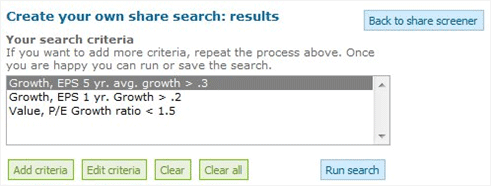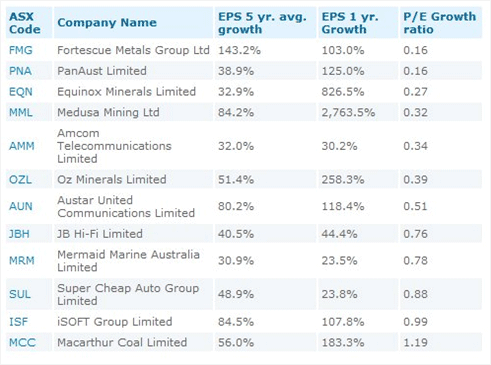What shares should I buy? Well, there are basically two types of stock: blue chip (income stocks) and growth stocks. Of course there are subcategories like value, penny stocks, and the like. When investing, we usually are looking for a stock to pay dividends or a stock to go up in price. Income paying stocks are usually for a stable portfolio with lower payouts suitable for those in retirement or in a low risk category.
But what if we reserve a portion of our portfolio for stocks we expect to rocket in value?How would we pick such stocks?
Growth Stocks to Buy and Fundamentals
Growth stocks are always based in strong fundamental activity. As you can imagine, the earnings must be growing. Before we get too far ahead of ourselves we should find a fundamental stock and stock screener for the Australian market. There are very few good customizable choices available, but thankfully MSN provides all the options we need.
You can use the MSN fundamental stock and share screener here.
When it comes to growth we will look at past growth over five years as well as a more current growth period. The reason we look to growth averaged over the past five years is to get a realistic view if this is a company that fell on hard times and has had one ‘spring-back’ year, or whether the business is consistently improving the bottom line year over year in a stable manner.
First we add the following criteria to our customized stock screener
1. Growth, EPS 5 year average > .3
This means that over the last 5 years of EPS earnings, the companies with the highest averages will appear first on my fundamental screen and the minimum cut-off will be 30 percent annual growth. At the time I ran the screener (5/2010 ASX), over 115 of the 2112 stocks listed had a 5 year EPS growth rate of over 30 percent… and this is coming out of a global recession.
This still provides far too many stocks to choose from. Next we add a one year earnings growth factor.
2. Growth, EPS 1 year growth > .2
Keep in mind that if you are just coming out of a bear market or a recession, you will need to give lenience. It would be unrealistic to expect blockbuster growth during difficult economic times. If you are in a bull market you can screen for 30 percent or higher. If in a bear market or just coming out of a recession, consider slacking the criteria to 15 or 20 percent current annual growth.
The 115 stocks have now been dropped to in half, and we have 62 available companies remaining. We need to reduce this number yet again.
3. Value, P/E Growth ratio < 1.5
On its own the PEG ratio can be deceiving. If one was merely to screen for price to earnings ratios divided by growth and pick the low numbers, many blue chip stocks would appear. Why? Stocks with little upside movement that pay dividends have lower price to earnings ratios. If the stock is only expected to grow 6 percent next year, but the price to earnings is also 6, the PEG is one. Traditionally a PEG of one or less is a value opportunity and a PEG of over one is reserved for stocks overpriced based on future growth. However, since income stocks have low P/E’s, they sneak their way into our screening.
Since we first screened for high-growth stocks, we can now filter for PEG ratios of less than 1.5 to get stocks at a relative bargain. This has dropped our stock list to 12.


Other Modifications to the Share Filter Screener
Granted, there are many other numerous ways to filter for growth stocks. Here are a few modifications you could make:
Stocks That Turnaround
Some like to pick out-of-favor stocks with growth potential that have very low valuations. This could be the case for a high growth stock that has had miserable earnings over the past few years but suddenly has high expectations. If the company can produce future results, the rewards for you are quite high. On the other hand, the company has not been able to give bottom line results for some time. Our investing may be gearing towards credulity or the word of the company. Risk goes up.
Still, if this ‘bottom fishing for growth’ investment style is what you want, enter in the following criteria. Or you could just pick the turnaround stock tab in the MSN pre-screens.

Stocks that Are REALLY Growing
There is always the risk that you will screen for a high growth stock that has found a way to improve its bottom line earnings without boosting the overall company structure. For instance, if a company continues to make judicious cutbacks and sell off certain assets, the bottom line EPS could appear to grow. But such growth would be far from sustainable. The belt can only be tightened so far and then the company must find a way to expand outside of policy changes.
To prevent such a stock sneaking into your mix -- add the following two ingredients: revenue and book value.
By screening for increasing revenue over a 5 year period, you are ensuring that the earnings were created on the back of more overall money flowing into the company. If revenue was stagnant and earnings increased continually, this model would be highly suspect. We will not be as strict on revenue earnings since we need to allow for some management intelligence to help improve profit margins. Still, requiring 20 percent revenue growth per year based on a 5 year period is wise.
Next we want to ensure that the net asset value of the company is also growing. True, many growth companies will be re-investing their profits in advertising and research to continue to grow and these may not increase the net worth of the company. Still, we would like to see the profits increase the net worth of the company or something is wrong. If earnings were high and book value stayed the same, we should be worried. Where is the money going? Are assets being depreciated faster than the money coming in? Are assets being sold to create false EPS numbers? Since income is high, is the company assuming new debt like a drunken sailor?
Use the following screen to modify your share filter:

What Stocks Should I Buy? Which Growth Stocks Are Best?
When trying to identify the best growth shares to buy, first look for annual growth and sustained growth over a period of five years. From there we can modify our settings based on what we are looking for:
- A company with good valuation based on future growth
- A stock with bad earnings but a promising turnaround of future growth
- Shares with increasing revenue and book value for rock solid growth
By following the stock market tips in this article, you will know which growth shares to buy.